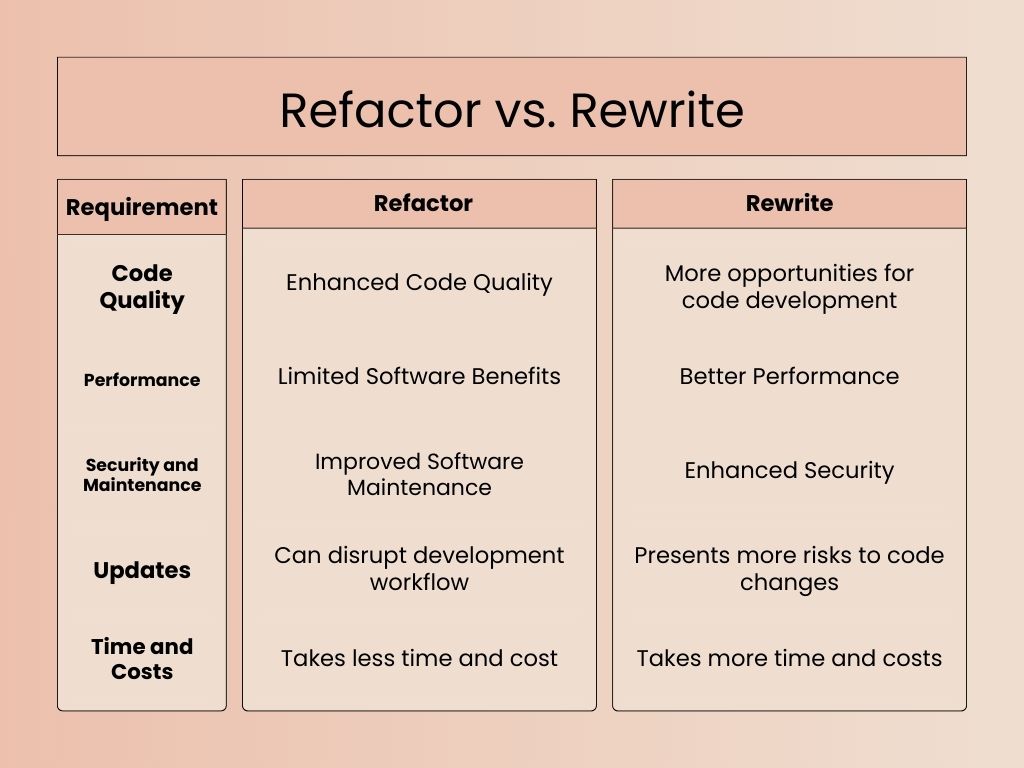Software engineers often face a crucial decision in their work: whether to refactor or rewrite their code. Joel Spolsky, the creator of Stack Overflow, highlights a core challenge in programming: reading code is generally harder than writing it. This complexity makes code reuse difficult and is one reason why development teams divide tasks—simplifying the process is just more efficient.
Dealing with legacy code or bringing someone new up to speed on an existing project can be daunting tasks that developers might prefer to avoid. However, the desire to start fresh with a rewrite must be balanced against the potential risks it introduces. Making the wrong choice could lead to versions full of bugs, programs that don’t work together, or even completely dysfunctional projects.
This presents developers with a classic dilemma: Should they enhance the existing code through refactoring or take the more drastic step of rewriting the program from scratch?

Refactor vs Rewrite
There is no rubric for choosing refactor vs rewrite, so you have to look at each of your projects to determine what best to do. As projects evolve, you will have to rethink how to move forward with them to ensure that you are making quality code.
Improving code can be compared to doing house improvements: on one hand, you can slowly but surely go through every area that needs improvement, or you could just demolish the old building to build a new one.
What is refactoring?
Refactoring is changing the internal structure of your code without changing its external functionality. In the metaphor of improving your home, you can think of it as a single-room renovation. Refactoring is a foundational practice for any development team that allows you to continuously enhance your software, like fixing bugs or issues or improving its general structure and functionality. This makes your program run smoother and easier to maintain.
When to Refactor?
In a Refactor vs Rewrite scenario, refactoring is almost always the go-to option for most situations, including the following:
- Making small improvements such as updates like addressing minor bugs, improving speed, enhancing user experience, and other future maintenance work.
- Adding new features and integrations into your existing system, such as adding GPS tracking for delivery trucks.
- Minimising risks by fixing problems without messing with parts of the code that are working well. Refactoring is safer if your software is already stable with a generally happy user base.
Imagine a software platform designed to support clients filing for divorce in Queensland. In this case, refactoring was the best approach to improve the dashboard functionality without disrupting the stable core system. By refactoring, we introduced enhancements that allowed clients to receive real-time notifications as soon as updates became available on their divorce process. This approach not only streamlined the user experience but also ensured the system remained reliable for its existing user base.
What is rewriting?
Rewriting serves more of a last-ditch effort for when the existing code and software become a house on fire – repairing it would cost too much, and it’s not worth your time and effort to try to save the program, so you break it and start over. However, the difficult part of the process is determining whether the program is on fire. For instance, systems with an extensive user base will likely have many extra lines of code that serve their purpose. These extra lines have likely been added over the years to fix bugs or address end-user issues, leading to catastrophic consequences if deleted.
When to Rewrite?
Sometimes, your code needs a complete overhaul to work better. Developers can opt for a total redesign by doing a complete makeover of their software, like getting a new brand identity for their business.
You may need to completely rewrite your code when you want to improve on the following:
- Upgrade obsolete technology from the old systems the code is built on can no longer be upgraded as quickly, like when parts of your house have materials that the supplier no longer manufactures.
- Create new functionalities to your design, like introducing extensive functionality that may outweigh the existing functionality.
- Redo unfixable code when the program is a mess and so poorly written that improvements become impossible, in which case it is better to move forward with a rewrite.
Rewriting is a process that requires a thorough analysis of the existing code and a clear vision of what you want your program to do in the future. It must also be well-defined so your developers can execute it properly. Because your software already has existing functions, you should not underestimate the complexity of a rewrite—many developers underestimate the time and effort required in this endeavour, so they tend to regret it later.
We helped a real estate client improve Pre-Settlement Inspection management. What started as a simple UI update turned into a full rewrite when we discovered outdated backend logic. Hidden complexities like legacy code and user workflow issues extended the timeline, highlighting how critical planning is for a successful rewrite.

Deciding between refactoring vs rewrite
Rewriting is a serious undertaking that requires a lot of time, money, and resources. However, before you decide to jump ship, you may want to take some time to analyse your current software. Decide what needs fixing, what goals are necessary for the future, and whether there are ways to achieve them through factoring.
If you’re unsure which path to take, you can take our free quiz to help you identify your software’s strengths and weaknesses and determine your best course of action.
Understanding the difference between refactoring and rewriting can help you make an informed decision about how to keep your software running smoothly. Remember that a well-maintained and efficient software system is like a reliable home that will protect you and your business, regardless of weather.
Got software you can’t seem to get off the ground? Get in touch with us, and we will help you find solutions to your problems.




